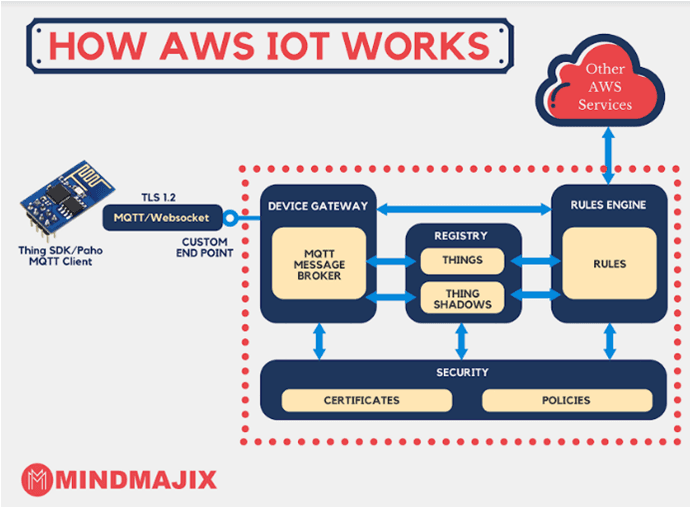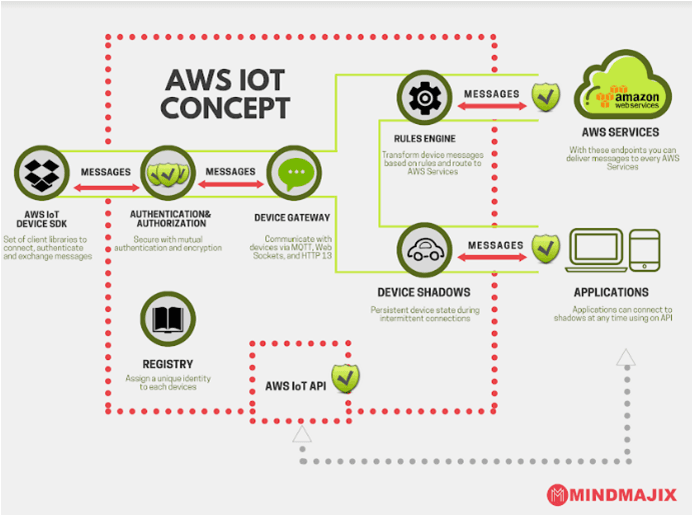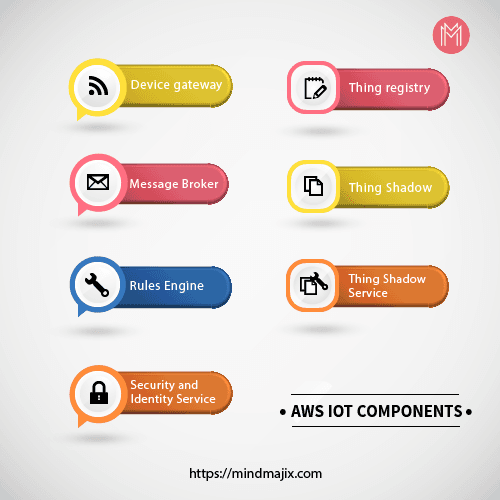- Introduction to Amazon Elastic File System
- Amazon On-Demand Instance Pricing
- AWS Kinesis
- Amazon Redshift Tutorial
- Amazon SageMaker - AIs Next Game Changer
- AWS Console - Amazon Web Services
- AWS Architect Interview Questions
- AWS Architecture
- Amazon Athena
- Top 11 AWS Certifications List and Exam Learning Path
- How to Create Alarms in Amazon CloudWatch
- AWS CloudWatch Tutorial
- Introduction To AWS CLI
- AWS Configuration
- AWS Data Pipeline Documentation
- AWS EC2 Instance Types
- AWS Elastic Beanstalk
- AWS Elastic Beanstalk Available in AWS GovCloud (US)
- AWS Free Tier Limits and Faq
- AWS EC2 Instance Pricing
- Choosing The Right EC2 Instance Type For Your Application
- AWS Interview Questions And Answers
- AWS Key Management Service
- AWS Lambda Interview Questions
- AWS Lambda Tutorial
- What Is AWS Management Console?
- Complete AWS Marketplace User Guide
- AWS Outage
- AWS Reserved Instances
- AWS SDK
- What is AWS SNS?
- AWS Simple Queue Service
- AWS SysOps Interview Questions
- AWS vs Azure
- AWS Vs Azure Vs Google Cloud Free Tier
- Introduction to AWS Pricing
- Brief Introduction to Amazon Web Services (AWS)
- Clean Up Process in AWS
- Creating a Custom AMI in AWS
- Creating an Elastic Load Balancer in AWS
- How to Deploy Your Web Application into AWS
- How to Launch Amazon EC2 Instance Using AMI?
- How to Launch Amazon EC2 Instances Using Auto Scaling
- How to Sign Up for the AWS Service?
- How to Update Your Amazon EC2 Security Group
- Process of Installing the Command Line Tools in AWS
- Big Data in AWS
- Earning Big Money With AWS Certification
- AWS Certification Without IT Experience. Is It Possible?
- How to deploy a Java enterprise application to AWS cloud
- What is AWS Lambda?
- Top 10 Reasons To Learn AWS
- Run a Controlled Deploy With AWS Elastic Beanstalk
- Apache Spark Clusters on Amazon EC2
- Top 30 AWS Services List in 2024
- What is Amazon S3? A Complete AWS S3 Tutorial
- What is AMI in AWS
- What is AWS? Amazon Web Services Introduction
- What is AWS Elasticsearch?
- What is AWS ELB? – A Complete AWS Load Balancer Tutorial
- What is AWS Glue?
- AWS IAM (Identity and Access Management)
- What is Cloud Computing - Introduction to Cloud Computing
- Why AWS Has Gained Popularity?
- Top 10 Cloud Computing Tools
- AWS Glue Tutorial
- AWS Glue Interview Questions
- AWS S3 Interview Questions
- AWS Projects and Use Cases
- AWS VPC Interview Questions and Answers
- AWS EC2 Tutorial
- AWS VPC Tutorial
- AWS EC2 Interview Questions
- AWS DynamoDB Interview Questions
- AWS API Gateway Interview Questions
- How to Become a Big Data Engineer
- What is AWS Fargate?
- What is AWS CloudFront
- AWS CloudWatch Interview Questions
- What is AWS CloudFormation?
- What is AWS Cloudformation
- Cloud Computing Interview Questions
- What is AWS Batch
- What is AWS Amplify? - AWS Amplify Alternatives
- Types of Cloud Computing - Cloud Services
- AWS DevOps Tutorial - A Complete Guide
- What is AWS SageMaker - AWS SageMaker Tutorial
- Amazon Interview Questions
- AWS DevOps Interview Questions
- Cognizant Interview Questions
- Cognizant Genc Interview Questions
- Nutanix Interview Questions
- Cloud Computing Projects and Use Cases
- test info
What is AWS IoT?
AWS IoT Core is a cloud platform that lets you connect devices across the AWS services cloud. AWS IoT provides the interface which allows the devices to communicate securely and reliably in bi-directional ways to the AWS touchpoints, even when the devices are offline. This article lets us understand how AWS IoT works.
AWS IoT Tutorial - A Complete Guide
| In this tutorial, we will cover below topics: |
How does it work?
AWS IoT allows Internet-connected devices such as sensors, embedded devices, and applications to connect and communicate over the AWS cloud. IoT applications Collect the information and process it sends messages in JSON format on MQTT topics.
Every MQTT can trace the device when it gets updated. When a message is sent across on the MQTT topic, it's passed to the MQTT message broker which distributes that message on the MQTT topic to the users who have subscribed to that topic.
The communication via the Internet-connected devices and the AWS IoT is secured through X.509 certificates. AWS IoT certificate has to be registered and activated using AWS IoT, to communicate with AWS IoT device you can then copy it onto your device which acts as a credential.
| If you want to enrich your career and become a professional in IoT, then visit Mindmajix - a global online training platform: "IoT Online Certification Training" This course will help you to achieve excellence in this domain. |

| Related Blog: Azure IoT Edge Overview |
All the devices connected across AWS IoT need to be in the registry. The registry has all the details of the certificates to interact effectively with AWS IoT.
To perform actions such as edit, update and delete a DynamoDB table or call Lambda function. Rules can be set to perform the specified action and filter messages. When particular rule tallies with the message, the rules engine trigger to perform the action based on the properties.
It also contains an IAM role that permits the AWS IoT access to the resources to do the particular action.
AWS IoT helps devices to establish the connection with devices to the AWS cloud. The medium to communicate which IoT supports are:
MQTT implies MQ Telemetry Transport, which is a lightweight and easy protocol that is built for low bandwidth devices having less reliable networks. It’s designed to reduce the network bandwidth and also minimize the resource requirements which assures stability and a good extent of delivery. This assumption helps Machine to Machine (M2M) and mobile applications where there is good quality bandwidth.
The TLS protocol provides a channel for the client-server applications to interact via a network which is built to prevent issues such as tampering because protocols can work irrespective of having a TSL, it's essential that the customer has to notify the server to establish a TLS connection. It can be done in two ways. One way is to employ a distinct port number to secure a TLS connection. The second method is to use a protocol mechanism that can be used for the client to prompt the server to switch to the TLS connection.
If you want to grow in your career or looking to jump to the next level of your job, then learning an AWS training course and holding an AWS certification is an important asset to you.
Ports supported by MQTT include:
- TCP/IP port 1883 is reserved with IANA for use with MQTT.
- TCP/IP port 8883 is also registered, for using MQTT over SSL.
AWS IoT- The Best Platform for Building, Managing, and analyzing the Internet of Things
AWS IoT has established the IoT connection to manage a cloud computing platform that can easily connect the devices and secure way of interaction with various applications of the cloud and various devices. It’s designed to handle the millions of data exchange and the millions of devices within the cloud that interact, process, and direct messages across AWS endpoints.
AWS IoT can actively communicate with Lambda, what is Amazon S3, and all other services to create IoT applications that handle vast volumes of data and handle the infrastructure. It’s a unified platform that makes the work of a developer easy, as it absorbs the flow of incoming data from several devices by using some protocols such as MQTT & HTTPS.

Such cloud associated installed systems instantly connect to the internet in both direct or indirect ways by using the resources mentioned below:
- Remote Diagnostics and Field Re-Programmability
- Order Fulfillment
- Remote Data Storage and Processing
- Consumer Insight and Advertising
- Remote command and Control
- Profile and Status
- Push Notifications
| Related Article: Reasons to Learn IoT |
How to kick Start i.e AWS IoT
One can have several ways to get started with IoT which primarily depends on the use case and its way of integrating into the use case. Many numbers of cases start with AWS IoT that mainly depends on the specific use case & the way of integrating service into the use case.
To connect & handle all the AWS IoT resources within the cloud, the AWS Management console supports a web-based interface. AWS IoT handles and manages several third-party tools and gateways such as:
- AWS IoT Management Console
- AWS SDKs
To get started with various Devices
- AWS IoT Devices SDKs
- AWS IoT starter kits Powered by AWS
Let’s look at the AWS IoT components in detail
Device gateway: It helps various devices to interact efficiently across AWS IoT. It’s like a starting point to access the IoT devices that are connected to AWS. The device gateway handles all the device connections to ensure they are connected securely and can communicate with the IoT core. Device Gateways connect MQTT and HTTP protocols which ensures that the communication is bi-directional which sends and receives information with low latency.
Message Broker: It provides a reliable and safe mechanism for several AWS IoT applications to both send, receives, and publish info. We can use the following tools like MQTT protocol or MQTT over WebSocket.
Rules Engine: Processing the message and integration with other components of AWS services. SQL is used to choose data from message payloads and transmit the data across other devices.
Security & Identity Service: AWS cloud caters to reliability and secures which stores all the credentials and information secured and transmits the necessary data to the message broker.
Thing Registry: Also called as some part of the device registry, where you and team up to three custom attributes.
Thing Shadow: Also called Device Shadow in which the JSON documents are secured and retrieved.
Thing Shadow Service: It gives continuous presentations of elements present in the AWS cloud. The revised info shall be distributed easily and can be aligned with the current state when it can connect.
AWS Mobile SDK for Android: It gives you the flexibility to build Android applications quickly.
Related Article: AWS DevOps Interview Questions
What Does AWS IoT offer?
Basically, it establishes a connection between the devices and the AWS cloud. AWS IoT enables interaction between other connected devices, low latency & overhead. Some of the big providers of AWS IoT back up several communication protocols like HTTP, MQTT, WebSockets which are well supported. The interactions are well secured using TLS.
- The connection across the devices and AWS cloud.
- Processing data delivered across several connected devices
- The application communicates over devices connected across AWS IoT.
- AWS IoT helps achieve flexible, low-cost scalable solutions for SMEs to corporates.
What’s the use of AWS IoT?
- Performing the below tasks is possible using AWS IoT:
- We can gather data from several IoT devices to analyze the data.
- You can use the AWS IoT service to create an application and via using that application, we can support IoT devices across smartphones and tablets.
- Storing data from IoT devices is possible and that data can be applied to Big Data and Machine Learning.
Why is AWS IoT in great demand
AWS IoT is gaining immense popularity as the most opted technology as it establishes a secured connection for the internet-connected devices and the AWS. It sets up a reliable connection to the complex network that sends data to the Amazon Virtual Private Cloud (Amazon VPC).
IoT makes it easy to use AWS services like AWS CloudTrail, Lambda, Amazon S3 and so on which have built-in integration. It’s designed to take the input, process the data, and send it back to the connected devices.
Amazon Web Services IoT
AWS IoT is a cloud platform that allows us to connect to devices that are connected using the Internet. The devices connected to the Amazon Cloud use a secure and reliable connection for the end-user.
Amazon Web Services (AWS) came up with the idea to meet the requirements of every customer who is in need of these AWS services. Some of the services AWS provides include:
Amazon EC2 Amazon Elastic Compute Cloud is designed to help you to gain access and boot new services, which you can build using a new VM in a matter of few seconds, it's also flexible and you can scale up or down depending on the requirement.
Amazon S3 Amazon Simple Storage Service is a service built to store data of any size depending on how often you wish to access it.
Amazon DynamoDB provides NoSQL Database, this service can be used to retrieve information using millisecond waiting.
AWS IoT AWS Internet of Things helps connect IoT devices with the cloud infrastructure to send, process, and store the data to apply machine learning and big data techniques.
Amazon EC2 Container Registry - Here you can build a Docker container and integrate it with a container via the Amazon EC2 service.
AWS Lambda helps us to run our code without the need for a server, your code will run in Lambda service through transparent means.
Elastic Load Balancing (ELB), helps Amazon users to deliver the traffic across several EC2 services.
Amazon CloudFront allows us to cater the content to the customers using the web or RTMP.
Amazon Elastic Block Storage, Amazon EBS provides us with the potential to have continuous storage that can be used with EC2, the storage is scaled for higher availability.
Amazon RDS -Amazon Relational Database Service (RDS) provides several engines for all the RD including Amazon Aurora, Oracle. MySQL, etc.
Amazon ElastiCache provides a web service that's flexible in a particular memory within the cloud. It provides support for two open sources either Memcached or Redis.
Amazon Redshift is a quick, secure, and petabyte measure data warehouse that provides easy, cost-effective solutions to all the current BI tools.
AWS Data Pipeline engages you to integrate, scale-up across AWS computing resources, and on-premises. Integration, Movement, and the process of data across AWS compute & storage resources, via your on-premises resources.
Amazon Elasticsearch Service (AES) makes the deployment and scaling tasks easier in the cloud zone. This service is a well-known open-source tool for use cases like log and clickstream analytics.
Amazon Cognito allows secure storage, managing, and syncing of several devices.
AWS Device Farm helps you to enhance the quality of Android, iOS apps by testing them across several smartphones, tablets in the AWS cloud.
Amazon SNS is a web service that allows customers to send and receive quick notifications within the cloud.
AWS CodeCommit helps you to build robust repositories that help you to share the code within the cloud.
List Of AWS Courses Offered By Mindmajix:
 On-Job Support Service
On-Job Support Service
Online Work Support for your on-job roles.

Our work-support plans provide precise options as per your project tasks. Whether you are a newbie or an experienced professional seeking assistance in completing project tasks, we are here with the following plans to meet your custom needs:
- Pay Per Hour
- Pay Per Week
- Monthly
| Name | Dates | |
|---|---|---|
| AWS Training | Jan 06 to Jan 21 | View Details |
| AWS Training | Jan 10 to Jan 25 | View Details |
| AWS Training | Jan 13 to Jan 28 | View Details |
| AWS Training | Jan 17 to Feb 01 | View Details |

Prasanthi is an expert writer in MongoDB, and has written for various reputable online and print publications. At present, she is working for MindMajix, and writes content not only on MongoDB, but also on Sharepoint, Uipath, and AWS.

















